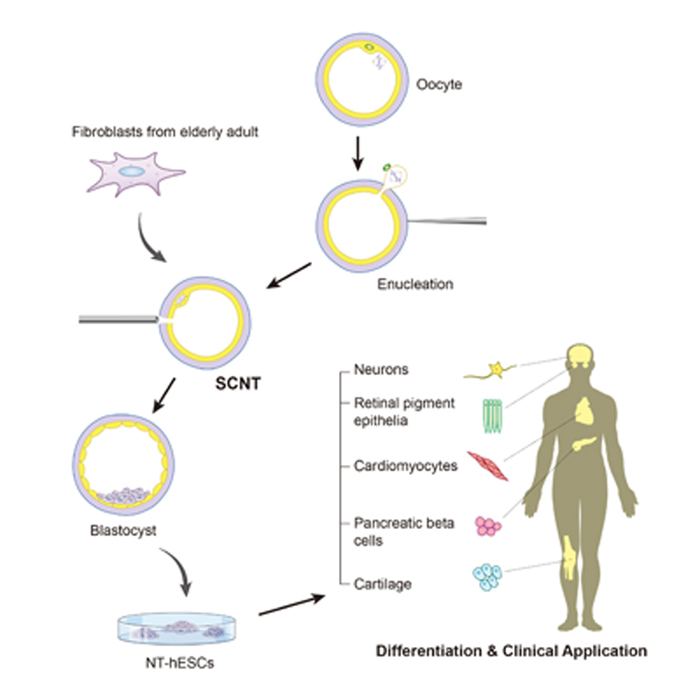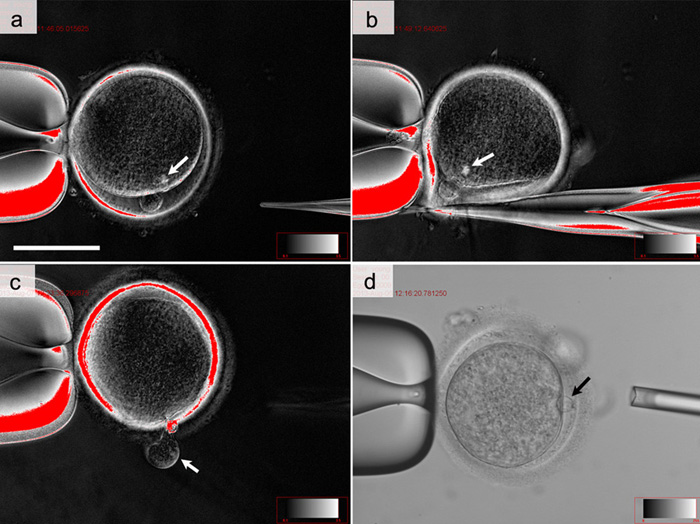Researchers have succeeded in cloning embryonic stem cells using adults' somatic cells for the first time in the world.
Embryonic stem cells are pluripotent stem cells that are derived from the inner cell mass of a blastocyst and which can differentiate into any type of cell. Derivation of patient-specific human pluripotent stem cells using a somatic cell nuclear transfer (SCNT) method has great potential for therapeutic applications. The research is expected to help develop cell therapy products to treat incurable diseases.
Stem cell researchers from the CHA General Hospital Group used dermal fibroblasts from a 35-year-old male and a 75-year-old male and 77 ova from four women. They were able to produce five blastocyst embryos. Finally, they succeeded in creating two embryonic stem cell lines.
Later they conducted chromosome tests and genetic marker analysis, concluding that they were cloned embryonic stem cells derived from somatic cells of the two males. Cell lines are cells that can continue to split, multiply and differentiate if under proper conditions.
Embryonic stem cells in fertilized eggs can eventually become any type of cell in the human body. Scientists have been studying how to use embryonic stem cells to produce regenerative medicines for incurable diseases or to redevelop damaged human body parts. In years past, ethical issues in relation to the use of fertilized eggs and immune rejection responses resulting from the transfer of embryonic stem cells into another person have both been barriers to the research.
However, using a somatic cell nuclear transfer (SCNT) method to derive embryonic stem cells has solved these problems. After separating a nucleus from the somatic cell of an adult, researchers inserted the nucleus into an enucleated ovum and were able to produce embryonic stem cells that have all the genetic characteristics of the original somatic cells. Most patients suffering from incurable diseases are adults and it is imperative to produce SCNT-derived embryonic stem cells by using cells of the patients themselves. This SCNT method has many advantages because it involves neither the use of fertilized eggs nor causes immune rejection responses.

Last year, U.S.-based scientists have succeeded in producing SCNT-derived embryonic stem cells using fetal or infant somatic cells, but this is the first time to produce SCNT-derived embryonic stem cells with somatic cells from adults.
The research was partly supported with a grant from the Sung Kwang Medical Foundation and from a program funded by the Ministry of Science, ICT and Future Planning. The results were published online in Cell Stem Cell, a journal specialized in stem cell research.
"It is meaningful that it is possible to produce SCNT-derived embryonic stem cells using the somatic cells of adults," said professor Lee Dong-ryul, a member of the research team. "We will be able to develop ways to do therapeutic treatment depending on the ability of stem cells to differentiate. We can start clinical trials in one or two years and come up with actual medicines within five years."
By Limb Jae-un
Korea.net Staff Writer
jun2@korea.kr

Embryonic stem cells are pluripotent stem cells that are derived from the inner cell mass of a blastocyst and which can differentiate into any type of cell. Derivation of patient-specific human pluripotent stem cells using a somatic cell nuclear transfer (SCNT) method has great potential for therapeutic applications. The research is expected to help develop cell therapy products to treat incurable diseases.
Stem cell researchers from the CHA General Hospital Group used dermal fibroblasts from a 35-year-old male and a 75-year-old male and 77 ova from four women. They were able to produce five blastocyst embryos. Finally, they succeeded in creating two embryonic stem cell lines.
Later they conducted chromosome tests and genetic marker analysis, concluding that they were cloned embryonic stem cells derived from somatic cells of the two males. Cell lines are cells that can continue to split, multiply and differentiate if under proper conditions.

The process of producing and using somatic cell nuclear transfer (SCNT) methods to create embryonic stem cells for therapeutic purposes. (image courtesy of the CHA General Hospital Group)
Embryonic stem cells in fertilized eggs can eventually become any type of cell in the human body. Scientists have been studying how to use embryonic stem cells to produce regenerative medicines for incurable diseases or to redevelop damaged human body parts. In years past, ethical issues in relation to the use of fertilized eggs and immune rejection responses resulting from the transfer of embryonic stem cells into another person have both been barriers to the research.
However, using a somatic cell nuclear transfer (SCNT) method to derive embryonic stem cells has solved these problems. After separating a nucleus from the somatic cell of an adult, researchers inserted the nucleus into an enucleated ovum and were able to produce embryonic stem cells that have all the genetic characteristics of the original somatic cells. Most patients suffering from incurable diseases are adults and it is imperative to produce SCNT-derived embryonic stem cells by using cells of the patients themselves. This SCNT method has many advantages because it involves neither the use of fertilized eggs nor causes immune rejection responses.

The steps involved during a somatic cell nuclear transfer (SCNT). (a) A human ovum. (b) The pellucid zone, located below an area containing the genetic material of the ovum, is incised using a knife pipette. The arrow points to the genetic material to be enucleated. (C) A cytoplasm containing genetic material from the ovum is eliminated using a knife pipette. (d) The nucleus of an adult male is inserted into an enucleated ovum. (images courtesy of the CHA General Hospital Group)
Last year, U.S.-based scientists have succeeded in producing SCNT-derived embryonic stem cells using fetal or infant somatic cells, but this is the first time to produce SCNT-derived embryonic stem cells with somatic cells from adults.
The research was partly supported with a grant from the Sung Kwang Medical Foundation and from a program funded by the Ministry of Science, ICT and Future Planning. The results were published online in Cell Stem Cell, a journal specialized in stem cell research.
"It is meaningful that it is possible to produce SCNT-derived embryonic stem cells using the somatic cells of adults," said professor Lee Dong-ryul, a member of the research team. "We will be able to develop ways to do therapeutic treatment depending on the ability of stem cells to differentiate. We can start clinical trials in one or two years and come up with actual medicines within five years."
By Limb Jae-un
Korea.net Staff Writer
jun2@korea.kr
